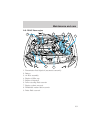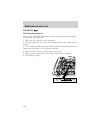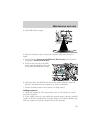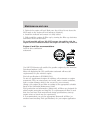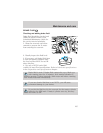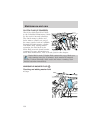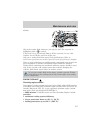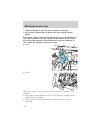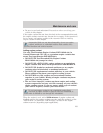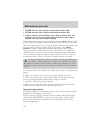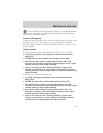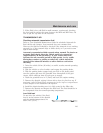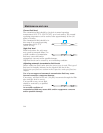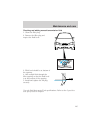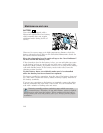
• Be sure to read and understand Precautions when servicing your
vehicle in this chapter.
If the engine coolant has not been checked at the recommended interval,
the engine coolant reservoir may become low or empty. If the reservoir is
low or empty, add engine coolant to the reservoir. Refer to Adding
engine coolant in this chapter.
Automotive fluids are not interchangeable; do not use engine
coolant, antifreeze or windshield washer fluid outside of its
specified function and vehicle location.
Adding engine coolant
Use only Ford Premium Engine Coolant E2FZ-19549-AA (in
Canada, Motorcraft CXC-10) or a premium engine coolant that
meets Ford specification ESE-M97B44-A.
• DO NOT USE Ford Extended Life Engine Coolant
F6AZ-19544-AA (orange in color).
• DO NOT USE a DEX-COOL engine coolant or an equivalent
engine coolant that meets Ford specification WSS-M97B44-D.
• DO NOT USE alcohol or methanol antifreeze or any engine
coolants mixed with alcohol or methanol antifreeze.
• DO NOT USE supplemental coolant additives in your vehicle.
These additives may harm your engine’s cooling system.
• DO NOT MIX recycled coolant and conventional coolant
together in your vehicle. Mixing of engine coolants may harm
your engine’s cooling system.
• The use of an improper coolant may harm engine and cooling
system components and may void the warranty of your vehicle’s
engine cooling system. If you are unsure which type of coolant
your vehicle requires, contact your local dealer.
Do not put engine coolant in the windshield washer fluid
reservoir. If engine coolant is sprayed onto the windshield, it
could make it difficult to see through the windshield.
When the engine is cool, add a 50/50 mixture of engine coolant and
distilled water to the engine coolant reservoir, until the coolant is at the
“cold fill level” or within the “cold fill range” as listed in the engine
coolant reservoir (depending upon application).
Maintenance and care
139



